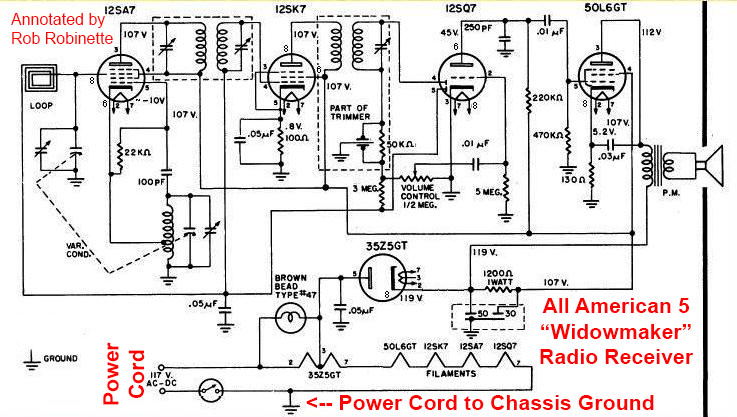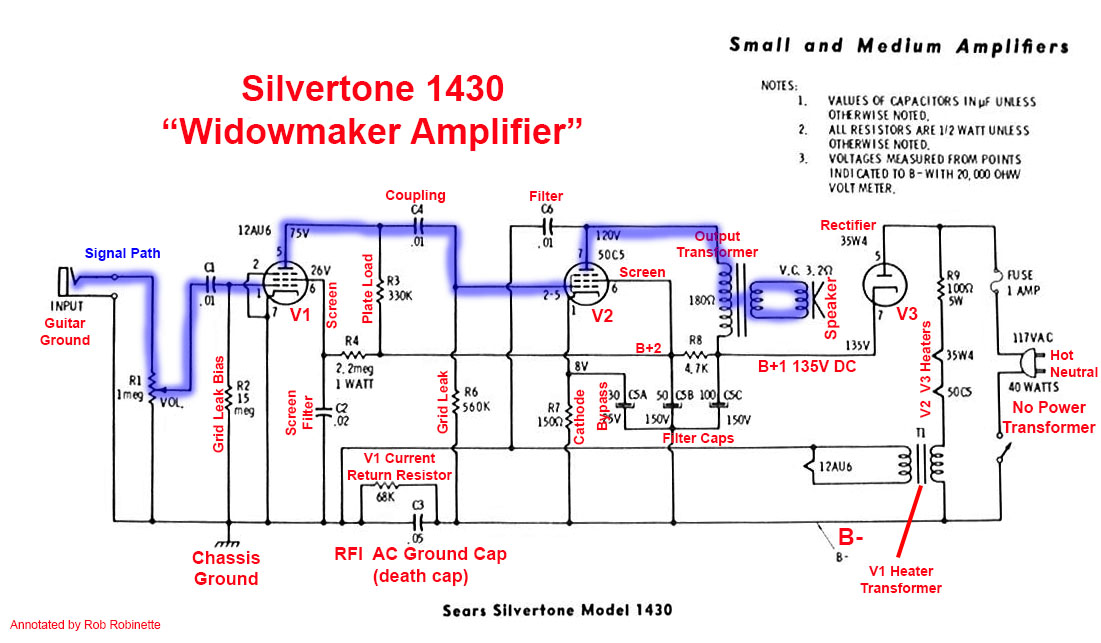I'm trying to nail down my understanding of the dangers of "widowmaker amps" so could you review the below and let me know what I have wrong.
I have yet to see an amplifier schematic that shows either power cord (mains) wire connected directly to the chassis like the 1940s All American Five radio receiver below. This radio is wired as a true widowmaker but the chassis is insulated from the user to prevent shock.
Does anyone have direct experience with a widowmaker with one of the mains wires connected directly to the chassis?

This Silvertone 1430 below is a "widowmaker" but it's metal chassis and input jack ground are isolated from the mains by the C3 RFI AC Ground Cap and 68k V1 cathode resistor. The C3 Ground Cap seems to function just like a "death cap" going from mains to chassis.

With the power cord backwards the chassis would be hot with mains voltage but max current would be limited by the C3 RFI cap and 68k cathode resistor to about 4.2ma with 125v mains voltage.
We could install a three prong power cord in this amp and connect the chassis to the safety ground but if you plugged into an outlet that had its hot and neutral reversed you'd short hot to the chassis safety ground and pop a circuit breaker (best case anyway). This is one reason why electrical code doesn't allow you to connect neutral and ground anywhere beyond the building's service entrance.
Adding an isolation transformer to the 1430 above removes the mains neutral ground reference from the amp circuit. We could actually touch either isolation transformer secondary lead and not be shocked because the secondary isn't referenced to ground--the voltage is from secondary lead-to-lead, not lead to ground.
After an isolation transformer is installed we can safely and legally add a safety chassis ground.
I have yet to see an amplifier schematic that shows either power cord (mains) wire connected directly to the chassis like the 1940s All American Five radio receiver below. This radio is wired as a true widowmaker but the chassis is insulated from the user to prevent shock.
Does anyone have direct experience with a widowmaker with one of the mains wires connected directly to the chassis?

This Silvertone 1430 below is a "widowmaker" but it's metal chassis and input jack ground are isolated from the mains by the C3 RFI AC Ground Cap and 68k V1 cathode resistor. The C3 Ground Cap seems to function just like a "death cap" going from mains to chassis.

With the power cord backwards the chassis would be hot with mains voltage but max current would be limited by the C3 RFI cap and 68k cathode resistor to about 4.2ma with 125v mains voltage.
We could install a three prong power cord in this amp and connect the chassis to the safety ground but if you plugged into an outlet that had its hot and neutral reversed you'd short hot to the chassis safety ground and pop a circuit breaker (best case anyway). This is one reason why electrical code doesn't allow you to connect neutral and ground anywhere beyond the building's service entrance.
Adding an isolation transformer to the 1430 above removes the mains neutral ground reference from the amp circuit. We could actually touch either isolation transformer secondary lead and not be shocked because the secondary isn't referenced to ground--the voltage is from secondary lead-to-lead, not lead to ground.
After an isolation transformer is installed we can safely and legally add a safety chassis ground.

Comment